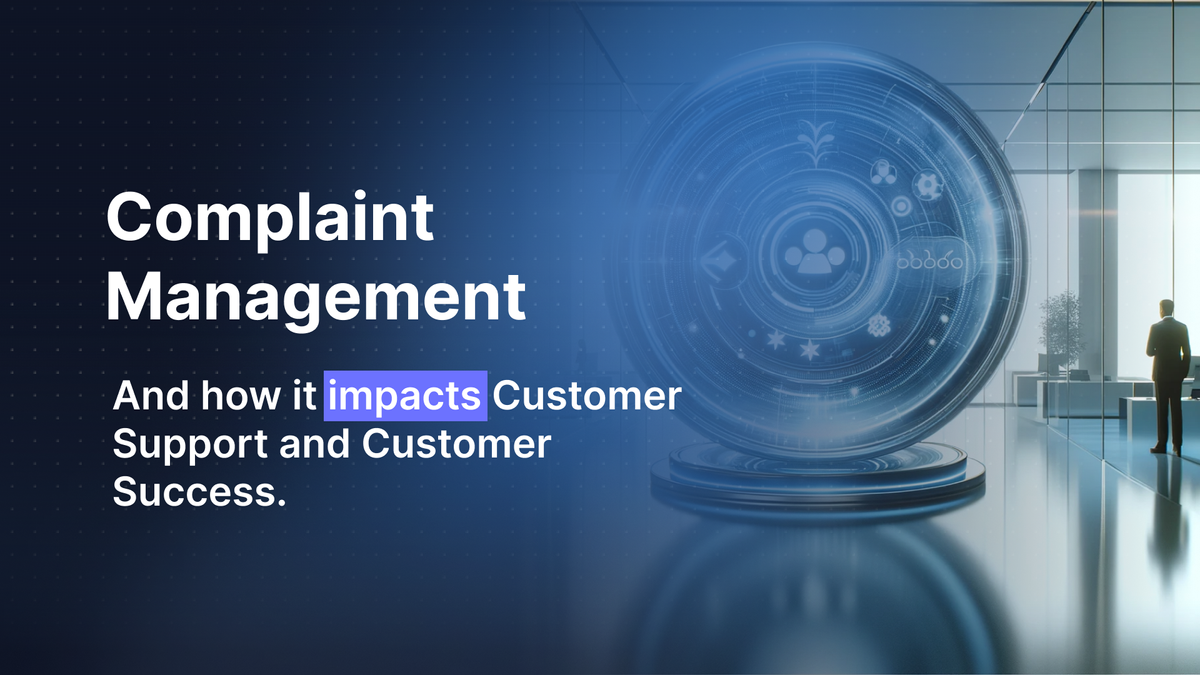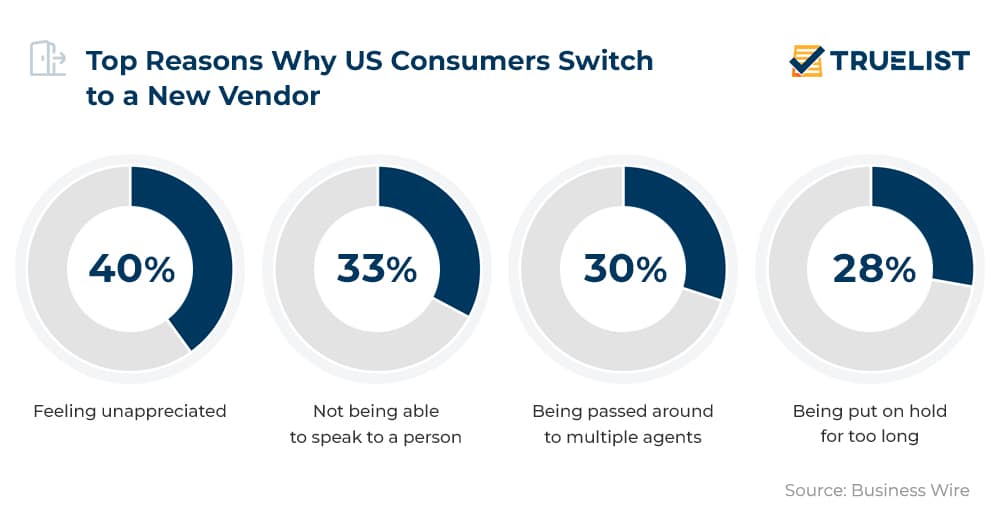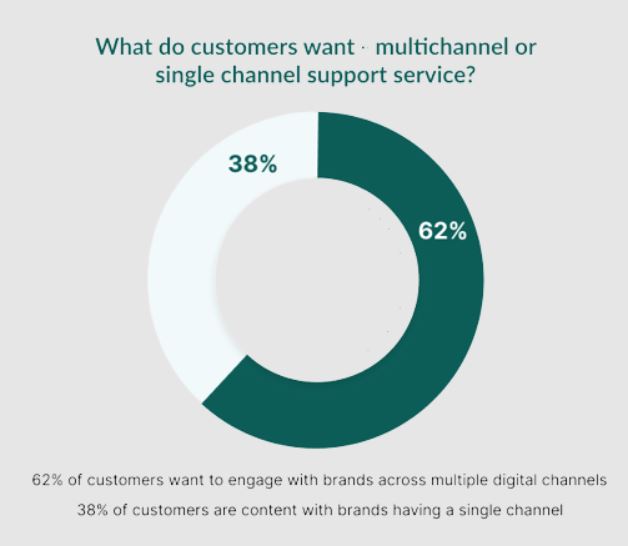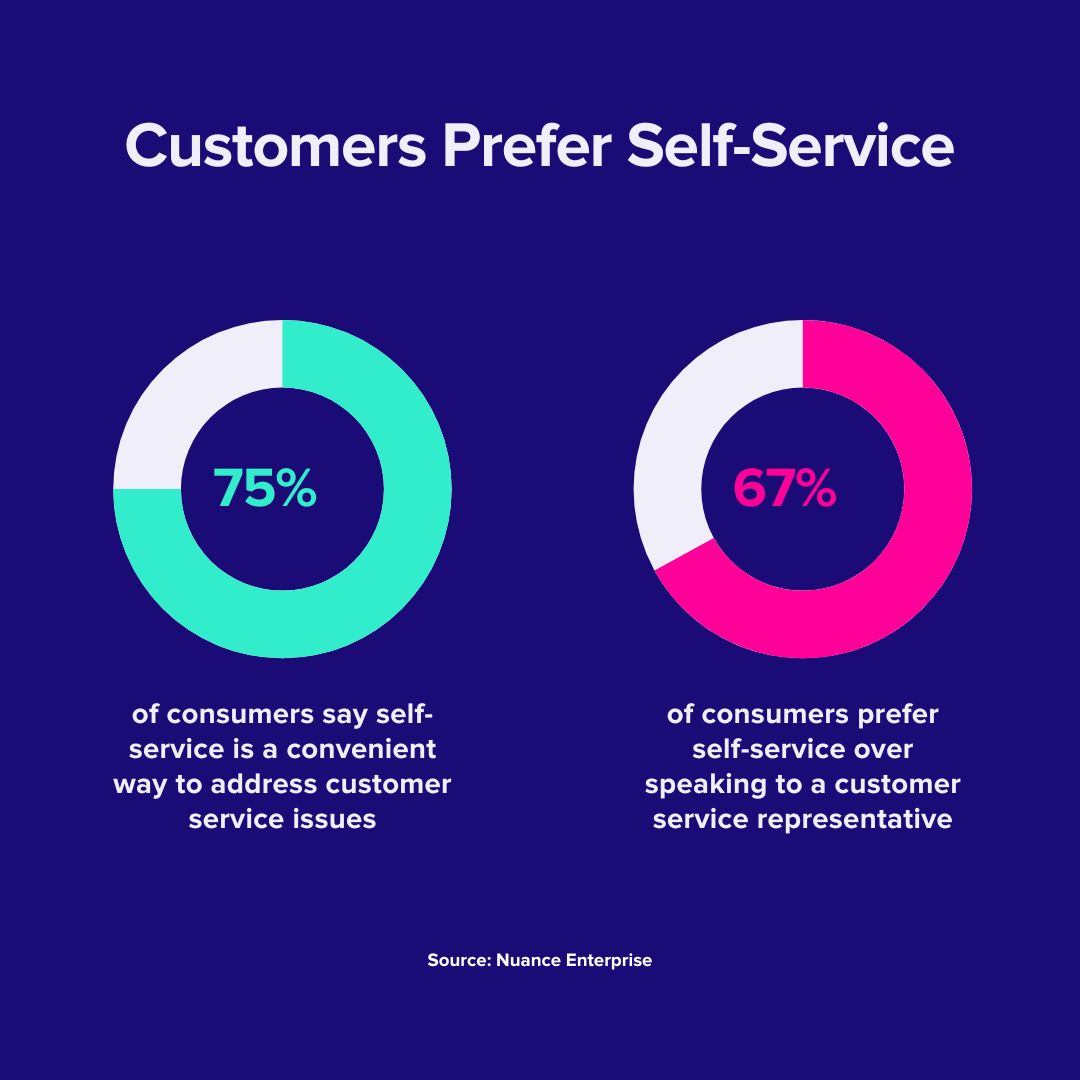You can turn customer grievances into compliments with a robust complaint man...

Customer complaints and negative feedback are something every business has to deal with at some point. Even the most successful businesses face issues like quality control, logistics, and similar factors that persist customers to reach out to the support staff and voice their complaints.
However, businesses are not evaluated on being error-free with zero complaints but on how well this feedback is addressed, acknowledged, and resolved for a better customer experience. Over 90% of customers in the world consider complaint management as the most crucial aspect of customer service, showing that complaint handling is not just an integral part but the lifeline of a successful business.
Let's find out more about the importance of effective complaint resolution and its impacts on a business in the long run.
A customer complaint is simply an expression of dissatisfaction from a customer about a product, service, or experience they had with a business. It could be the result of anything from a faulty product to poor service or a major inconvenience that leads customers to submit negative feedback.
Customers can voice their feedback and opinions to a company through different channels, such as phone, emails, messaging apps, and online review sites, to be heard and compensated.
Negative feedback and complaints are an inevitable part of any business. Customer complaint management is the process of how a company tracks, resolves, and offers solutions to customer grievances. It acts as the central hub of customer service, where all sorts of customer feedback and service-related issues are reported.
It may be difficult to believe, but customer complaints are not a negative thing at all. An angry customer is trying to communicate what is missing in your services and how you can work on it. A solid complaint management system helps businesses understand the needs of their customers, improves communication, and increases revenue generation. According to research on customer behavior in 2023:
83% of customers agreed that they feel more loyal towards brands that respond to and resolve their complaints.
The way you handle a complaint also decides between keeping and losing a customer. Lack of a solid complaint management system can affect your company's reputation, your employees' morale, and eventually, the revenue and business opportunities.

Let's discuss the most prevalent complaints and how your complaint management team should handle them appropriately.
Waiting is a regular part of life, but it can also become a serious issue when a customer is not able to connect with an agent and experiences a long hold time. It may also happen when someone has to wait in line for services, such as waiting in long queues at a food chain or retail outlet. Excessive waiting leads to angry and frustrated customers who are less likely to come back for a purchase. Research shows that slow response time can cause 52% of customers to stop buying from a business.
A long waiting time is an indication that your company needs to work on its customer service operations or hire more staff immediately.
You can expect to receive a client complaint when a product or service doesn't meet their standards. For example, a customer may explain that a piece of furniture they ordered came as broken or the dress they chose online had a different color. Address the customer's concern thoroughly and try to investigate the root cause of the problem for better complaint management.
A possible solution in this situation can be a refund or replacement. However, it is equally important to determine the accurate reason behind the customer complaint. If the customer needs to be using a product appropriately, try to correct them in a polite way to avoid this in the future. If the damage occurred during the delivery, try to improve your logistics.
Let's admit we all have our bad days! Whether it is the way of talking, lack of empathy, or miscommunication, some customers will not get along with your customer service team. If a customer service representative is not able to meet the desired standards of a customer, they usually think it is because of the lack of interest in their complaint.
When a customer expresses their concern about an encounter with an employee, validate their feelings and promise to address the issue by speaking with the staff member personally. Assuming you are in a managerial position, engage in dialogues about this incident directly with your personnel to understand both sides' viewpoints and identify possibilities for compromise. How a customer service agent interacts with a customer has a very deep and meaningful impact on your business.

Multi-channel support is the strategy of using different communication channels for a business to interact with customers. When a problem arises, customers want to connect with the complaint management team quickly for further assistance. If your business supports only one channel of communication, the customers are likely to face delays and difficulties in reaching out to your customer service team.
Statistics show that 62% of customers want to engage with businesses across multiple digital channels. This means if a customer initially reaches out to you through social media but needs detailed guidance through phone support, multi-channel support will ensure you meet their needs and provide a seamless customer service experience.

There are usually two scenarios in this situation. First, the customer made an online purchase of something that comes with an in-house demonstration. The customer will reach out to support staff through different channels for guidance on how to use a product properly.
Second, the customer has caught up with an issue that needs frequent follow-ups from complaint management people. Some people are patient and can't wait for a while, but others need ongoing support in the form of updates and follow-ups. If a service representative is not clear about the frequency of communication, your customers may think you are not interested in providing them adequate support.
To address this issue, your service representatives need to offer continuous assistance to customers while dealing with their complaints. Having a ticketing system in place makes the organization and prioritization of complaint handling easy. It helps the staff to handle active and time-sensitive cases first.
Imagine repeating your negative experience again and again and still not getting closure; it sounds frustrating. Customers also don't like to repeat their problems to different support staff. This happens when the complaint management system is not designed structurally.
If a customer is transferred from one service representative to another who lacks the necessary expertise or authority to address their specific concern, it can be an aggravating and time-consuming experience that reflects poorly on the company.
A good way to handle this is to employ professional staff who are trained in providing specialized customer services without long waiting times. There are numerous software that can manage and transfer customers' requests to appropriate agents quickly.
You must be wondering why I still need a complaint management strategy when almost all of the above-mentioned customer complaints can be resolved on the spot. Well, this is exactly the reason why you need one.
A complaint management strategy is a long-term road map of customer grievance handling. Effective customer support is not just about putting out fires and trying quick fixes when things go wrong. It starts from the initial complaint stage to its resolution and analysis, turning customers' frustrations into opportunities and continuously improving your business procedures.
Let's take a look at some of the most successful complaint management strategies and see how they can help you craft compliments from criticism:
Effective complaint management starts with a positive outlook towards customer feedback. Discuss with your customer service team that complaints are not something to be panicked about but how intelligently you tackle a challenging situation.
Start differentiating between complaints and requests. They are often used as the same terms in customer service. However, a complaint is a customer's dissatisfaction or disagreement with a product or service, whereas a request is a polite way of asking for a specific service or action.
For example, a customer has recently purchased a brand new dishwasher for their kitchen. They may formally send a request to the company to send a technician for installation. On the other hand, if the customer alleges that the company sent them a faulty or malfunctioning product, this will be categorized as a complaint.
Creating an action plan is an integral part of the complaint management process. Organizing complaints tickets into low, moderate, and high severity helps you decide which customers are high risk and need immediate attention and which customers can wait for a while.
Let's say a customer says that their credit card detail has been hacked and they are noticing unauthorized transactions, which means it is a high-risk complaint and should be dealt with on a priority basis. Similarly, if a customer requests their checkbook to be delivered at home, this can be considered a low-priority complaint.
People in customer service receive hundreds of complaints every day. Although every complaint comes from a different person, they are still very similar in terms of issues regarding late deliveries, defective products, invoices, billing, and so on.
Pre-designed response templates related to customer complaints help the customer service staff save time and effort while dealing with negative feedback. It also enables them to provide a consistent level of customer support through well-written professional responses and emails.
These templates, however, should be used carefully with a touch of personalization, such as adding the name or other relevant details of a customer so they don't feel treated like just another number, which can potentially damage customers' relations with a business.
Customers nowadays don't want to spend too much time talking to agents. Instead, they are more drawn towards self-service models. Customer self-service is a blend of different technologies such as chatbots, knowledge base, how-to guides, FAQs, and detailed articles about a service or product.
Self-service is a sustainable customer service model that both businesses and clients can benefit from. Customers can quickly find answers to a lot of their queries with a support system that is available 24/7. This can simplify and streamline complaint management for customer service staff, and they will be able to focus more on technical and urgent tasks.

Customer complaints highlight your areas for improvement and give you a chance to build better products and services. When you have a predefined complaint management process, it's easy to manage your brand reputation, build strong ties with new customers, and retain the old ones.
Using complaints as feedback opportunities and thoughtfully resolving them brings a whole new perspective to a business. Here are the key benefits of a positive complaint management system:
The reason behind most of the customer complaints is to let businesses know about their shortcomings and areas of improvement systematically. Nothing makes a customer happier than being listened to, acknowledged, and compensated respectfully.
Positive complaint management helps a business achieve enhanced levels of customer satisfaction with increased customer loyalty. If a company provides excellent customer support, 78% of customers are willing to come back for a purchase even after a mistake. People with a positive experience are going to stick with their favorite brands and even tell other people about it, hence businesses can retain old customers with new leads.
Customer complaints are the most direct and legitimate evaluation of your business. When a customer communicates to you that a product is not working to its full potential, it's an opportunity for you to rethink your research and development process. More than any focus group or marketing study, customer feedback is the real insight into where exactly your business needs improvement.
If there are more complaints about long waiting times, it means there needs to be more staff. Similarly, repeated requests for refund or exchange indicate that quality control needs a serious revamping.
Every customer complaint is a direct reflection of your employees' performance. A complaint management system identifies if your staff is helping people in the right way or not.
Try organizing the complaints according to each department and conduct regular meetings with your staff. Discuss the issues mentioned in them in an open environment and figure out how you all can work to turn these challenges into opportunities and improve your customer service.
Businesses today have multiple presences, such as websites, social media, and messaging apps, and each of them has its review section. This can become a very tricky situation if your complaint management is not handled with care. Customers usually check the review section of a brand before buying from it. Negative reviews can have a bad impact on your prospects, discouraging them from doing business with you.
To tackle this, train your team to instantly reach out to the customers who have posted an online complaint and try to resolve the matter privately, in a professional way. Avoid engaging in lengthy discussions and arguments on public forums. Once the matter has been resolved, politely request the customer to take down the review or give you a better rating. This is crucial for E-commerce businesses where online presence matters the most.
With a solid complaint management system in place and a competent customer service team, you can easily learn how to manage complaints from customers. Here are five steps for handling customer complaints based on the best practices.
Leave everything else aside and listen closely to what the customer is saying. An angry customer wants an empathetic ear that listens to them, validates their concerns, and acknowledges their problems. Active listening and empathy are the basis of successful complaint management.
It's good to take notes while talking to a customer; this will help you gain a better understanding of the core issue and areas of improvement. Keep asking questions to gain more clarity, such as:
Once you have collected all the relevant information regarding the issue, quickly offer an apology to the customer. At this point, it doesn't matter who is at fault, and it's more important to cool down the situation to make customers feel you are taking them seriously.
Once you have gathered all the necessary insights and acknowledged the customer, it's time to move on to the solution. The solution or compensation will depend upon the core issue of the complaint, such as refund, exchange, repair, or any future compensation. Keep all the options open and try to come to an agreement with the customer with inquiries like this:
Complaint management is a time-consuming process; staying engaged with customers ensures that the team is working on a solution.
Customers demand instant solutions to their problems. An ideal complaint management process should resolve most of the problems right away. It may vary for different issues. However, 24 hours is the preferred time frame to sort out any customer complaint.
A ticketing and complaint management software will help you prioritize the complaints according to their risk level.

Once the customer has agreed upon a solution, make sure that everything is working out at their end and the customer is content with the proposed compensation. Try to take honest post-complaint resolution feedback such as:
Ideally, it is good to reach out for detailed feedback after some days of complaint resolution so you can check out if everything is going well or not. It shows how efficiently your company is working towards customer service and complaint management.
Nobody minds a little more compensation than promised. The essence of exemplary complaint management is not just about providing effective solutions but also about making the customers feel heard and acknowledged and treating them as an asset to your company.
Similarly, when offering compensation for a bad experience, try to go a little above and beyond for your customers by offering incentives like discount coupons for the next purchase or a complimentary gift. This will leave an exceptionally positive impact on customers, and they are more likely to be your long-term partners.
Modern customer service and complaint handling demand transformative measures from businesses to provide an exceptional customer experience. The integration of AI in complaint management enhances the overall customer experience.